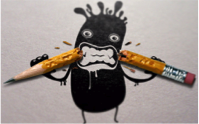Self-Critic Manny~ As a(n) old(er) writer, I’m always looking for ways to be kind to myself, to hang loose, to mute the voice of my haunting self-criticism that could easily paralyze my thinking if I let its nasty judgments fester and grow in my heart and mind. So familiar has that voice become, I’ve given it a gender and a name: Manny. When he appears, I talk to him —gently, kindly, welcoming him. Sound strange? Well, let me to tell you, befriending Manny rather than fighting him off makes it so much easier for me to send him on his way.
Writing-as-Teacher~ For years now whenever Manny stops by to rattle my confidence, I automatically draw on the wisdom found in, of all earthly powers, an Estonian proverb that I long ago memorized: “Let the work teach you how to do it.” What does that mean? How does it ward off my irritating friend, the speaker who would have me shut down? In truth, I’m not real sure how it works to help me maintain my equilibrium, but it does help. Maybe because those soothing words lead me past Manny and directly back to the writing, inviting me to concentrate only on the emerging text for these precious moments of truly listening to the writing —or whatever task or challenge is at hand for the time being. Maybe it’s a matter of being a thoughtful student of the writing, humbly allowing it to show me what I already know and need and want to learn. Ah, the dynamic of how that proverb settles me down and silences Manny remains a big mystery to me, but all I can say is that it puts me where I like to be: Making sense of the world I inhabit and my place within it by shaping aspects of it into story.
Writing Can Constrict Writing~ Do I then contradict myself when I suggest that sometimes a writer can work way too hard at the task, that struggling with the writing-as-teacher could very well exasperate the teacher, turning it away and silencing its helpful voice?
Well, I once again found myself caught up in this conflict when finishing the final draft of a story I’d been working on for well over a year. When I first happened onto the story, what I found was a fascinating Greek folk —not fairy— tale, curiously titled The Snake Tree, that my colleague Soula Mitakidou and I decided to include in our anthology of twenty Greek tales that bears the title, Folktales from Greece: A Treasury of Delights, (Libraries Unlimited, 2002).
I was no foreigner to the special effects that traditional tales are known for, starting with the rhythmic language, repetitive phrases, and interesting refrains —“the poetics of oral literature,” claims Richard Bauman, created by storytellers who passed the tale along by word of mouth, the intention of teller upon teller upon teller down through the ages being to entertain and edify an audience of one or many (Story, Performance, and Event, Cambridge U, 1986). We like and remember folktales for their stock characters that represent obvious traits or ideas and never reveal subtle personal characteristics; crystal clear themes that rise to the surface with no hidden agenda to be uncovered; and storylines that develop, as renown fantasy writer Philip Pullman puts it, “with a dreamlike speed from even to event” (Fairy Tales from the Brothers Grimm: A New English Version, Viking, 2012).
When I revisited The Snake Tree some years later I was one again intrigued by its concern for fate, destiny, and loyalty. The tale stayed with me, inviting me to reimagine it as a full-bodied fantasy. Some 15,000 words later, I have a story I will soon let go and send out hopefully to find an audience.
Trying Too Hard Hurts~ Recently, though, I almost lost the tale’s ability to teach me how to write it when I became fiercely tied up in describing my main character. Trying way too hard to make the description “perfect,” I was nearly on the brink of abandoning the entire writing enterprise. Forever.
Flash back. The dilemma that confounded me began the day Donald, my friend and colleague, and the tale’s illustrator and I were navigating our way through the manuscript looking for scenes that would be enlivened with illustration. “By the way,” Donald asked in passing, “have you described what [the main character] Loukas looks like?”
Gasp! Clutch! While I hope I had revealed Loukas through his actions, his temperament, his kindness, and his nearly tragic flaw, never once in the course of this 15,000-word story do I attend to his appearance, neither as a child nor as an adult.
I pondered. I fretted. As though chiding me for my negligence, Loukas refused to make his unique features known to me. I’m not talking here about a writer’s block. No, I’m talking about attempt after attempt after attempt at nurturing into existence an image I could believe in. Loukas is Greek. He lives on an island in the Aegan Sea. He’s a part-time fisherman, and an accomplished flute player. He’s friendly. Does he wear a smile? What else does he wear?
You see, every time I formed him into being, I felt I was creating an unappealing stereotype. Black-haired, bronze-tanned, broad shouldered, mustached Greek fisherman. A Zorba kin. Sigh!
STOP WRITING~ Then, early one morning, I’m reading Start Where You Are: A Guide to Compassionate Living by Pema Chrödrön, a Buddhist writer whose sound advice has become a guiding light for me as I move through each day. This morning Pema stops me in my writerly tracks with this bolt of advice: “…look at everything and appreciate it. Even if you don’t feel appreciation, just look. Feel what you feel; take an interest and be curious. Write less; don’t try to capture it all on paper. Sometimes writing instead of being a fresh take, is like trying to catch something and nail it down. This capturing blinds us and there’s no fresh look, no wide-open eyes, no curiosity.”
That did it for me. Hang loose. Relax. Take more than a few deep breaths in and out. Step back from the task (whatever it might be). Go for a walk, Pema advises. Sing out loud in the woods, she urges. Release yourself from the temptation to control the writing.
STOP WRITING! ~~for the time being …
RELEASE, RELIEF, RETURN~And then when you return, refreshed, to that divine process of composing, “Let the writing teach you how to do it.”
Now, whenever I step away from my fear of Loukas, he appears from the shadows and let’s me know what he wants to look like. By allowing him to teach me, he’s being much more cooperative. He’s almost fully formed, but only according to his clever suggestions for how he intends to appear before all who will hopefully meet him someday soon.
And thank you for stopping by to read my post today.






